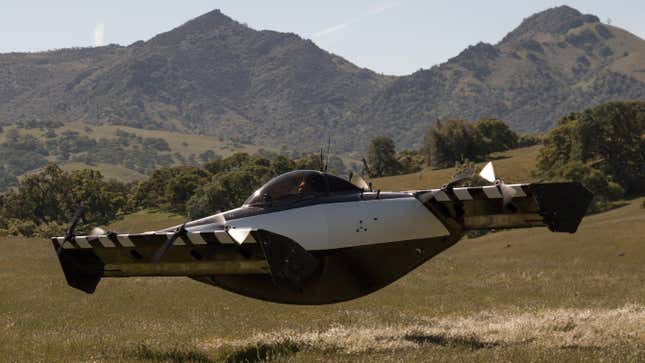
Every few months, or every few weeks, a company or publication will start talking about vehicles called “flying cars,” and they will become a thing again briefly, even though there is no such thing. I fear that time is again upon us.
On Saturday, The New York Times profiled the flying car startup Opener in a story that is headlined, “What Is A Flying Car?” Assemble the usual quotes and caveats, except this time flying cars are somehow a “movement”:
“Our dream is to free the world from traffic,” said Sebastian Thrun, another engineer at the heart of this movement.
That dream, most experts agree, is a long way from reality. But the idea is gathering steam. Dozens of companies are now building these aircraft, and three recently agreed to go public in deals that value them as high as $6 billion. For years, people like [Marcus Leng, a Canadian inventor] and Mr. Thrun have kept their prototypes hidden from the rest of the world — few people have seen them, much less flown in them — but they are now beginning to lift the curtain.
Mr. Leng’s company, Opener, is building a single-person aircraft for use in rural areas — essentially a private flying car for the rich — that could start selling this year. Others are building larger vehicles they hope to deploy as city air taxis as soon as 2024 — an Uber for the skies. Some are designing vehicles that can fly without a pilot.
The NYT does get around to the details, which are that Opener’s aircraft BlackFly gets around 25 miles per charge and will cost at least in the low six-figures. But also that those numbers will eventually, someday, somehow improve. There are also regulators to be dealt with (eventually), but the flying car people don’t think that is insurmountable either.
And then there are startups that sound like straight-up hucksters, like Joby, which has the Joby Aircraft, which is basically an all-electric helicopter that it plans to run in cities with pilots as a taxi service. That sure sounds like something that sort of already exists (here in New York City one can pay a company called Blade $795 to go to the Hamptons in a heli) but Joby insists there is a trillion dollars to be had. Eventually.
In an investor presentation, Joby touted a trillion-dollar market opportunity.
After launching in one city, the company says, it will quickly expand to others, bringing in $2 billion in revenue and more than $1 billion in gross profit within two years, according to its investor presentation. Until then, it will lose more than $150 million each year.
If anyone wants to give me $150 million a year, I, too, promise to eventually bring in massive profits. My Twitter DMs are open.
Anyway, established automakers are also prone to hype when it comes to flying cars, or air taxis, or urban air mobility solutions, or whatever you want to call them. Take Hyundai on Monday, per Reuters:
Hyundai is ahead of the timetable it previously laid out for the rollout of urban air mobility vehicles, also known as flying cars, Jose Munoz, Hyundai’s global chief operating officer, said in an interview broadcast on Monday at the Reuters Events Car of the Future conference.
Munoz, who is also CEO of Hyundai North America, previously said urban air taxis would be in operation at major U.S. airports by 2028, maybe earlier. The executive told Reuters on Monday it could possibly happen before 2025.
“We see this market as a significant growth opportunity,” Munoz said.
One thing that rarely gets talked about in these discussions is the willingness of a lot of people to go up in small aircraft on a regular basis. It is always just assumed that there are a lot who will, and maybe that is true — I’m sure these companies have plenty of market research — but, as someone who’s flown in a helicopter, I dunno man. It is not that small aircraft feel unsafe, exactly, it is mostly that they force you to confront the fact that you really are just sitting in a chair high in the sky.
Will we even have air taxis by the end of current decade? The companies trying to make them sure think so, though they have one big reason — attracting new investment — to say that. For the rest of us, the smart money is probably going elsewhere.